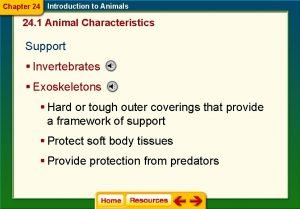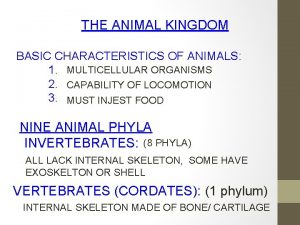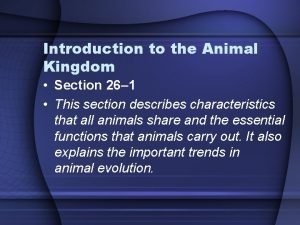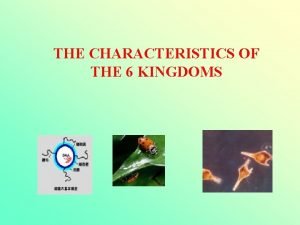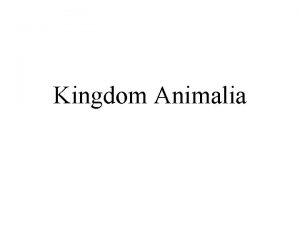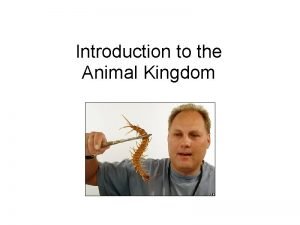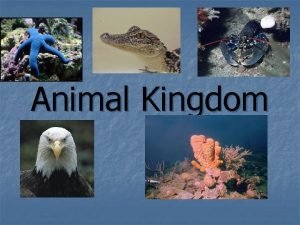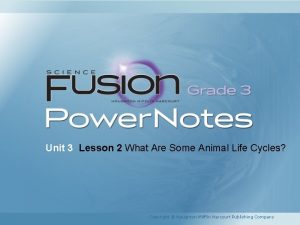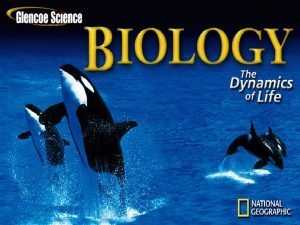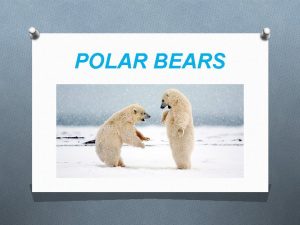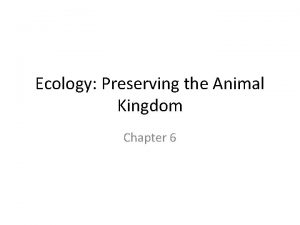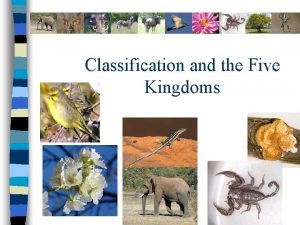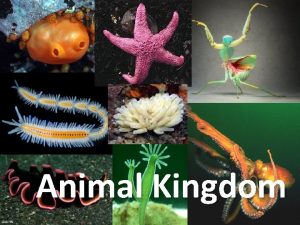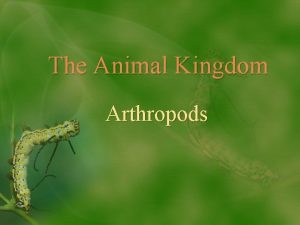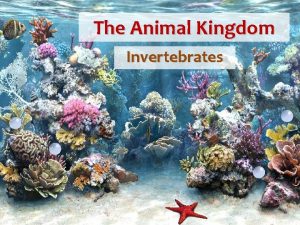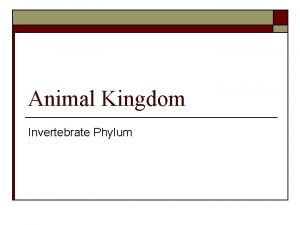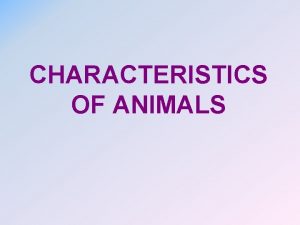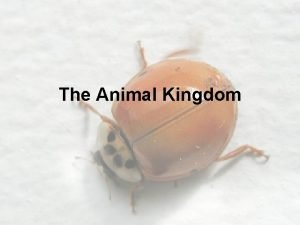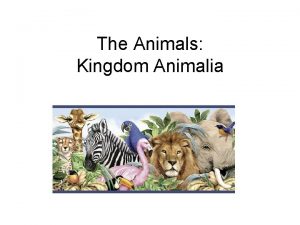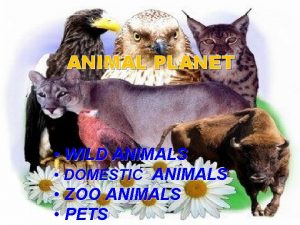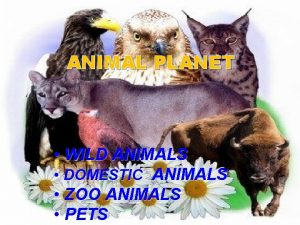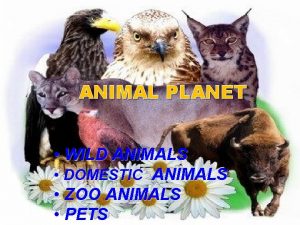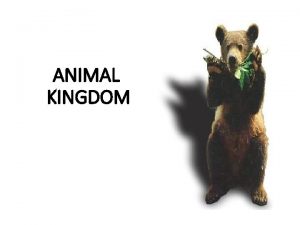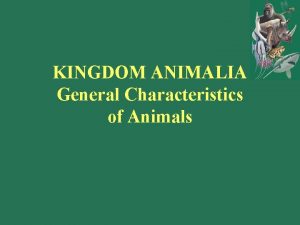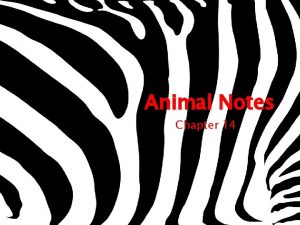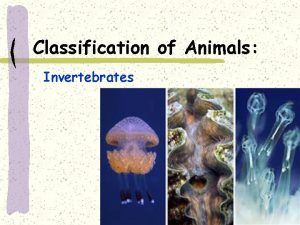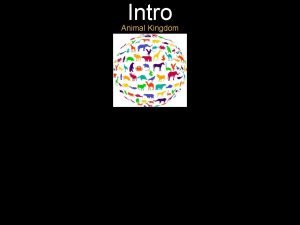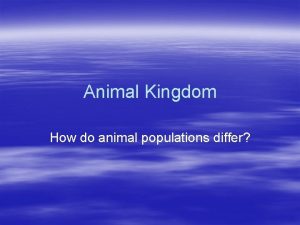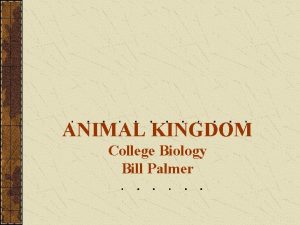Introduction to the Animal Kingdom Characteristics of Animals


























- Slides: 26

Introduction to the Animal Kingdom

Characteristics of Animals: Heterotrophic Eukaryotic Multicellular Lack cell walls 95% = invertebrates (no backbone) 5% = vertebrates (have a backbone)

7 Common Animal Functions 1. Feeding: Herbivore = eats plants Carnivore = eats animals Omnivore = eats plants and animals Detritivore = feed on decaying organic material Filter Feeders = aquatic animals that strain food from water Parasite = lives in or on another organism (symbiotic relationship)

2. Respiration: Take in O 2 and give off CO 2 Lungs, gills, through skin, simple diffusion

3. Circulation: Very small animals rely on diffusion Larger animals have circulatory system

4. Excretion: Removal of Wastes - Primary waste product is ammonia (could be urea, uric acid, or amino acid. A. Diffusion - Sponges, Cnideria, and Echinoderms. B. Flame cells - Flat worms C. Canals and Tubes - Round worms D. Nephridia - Annelids E. Malphigian Tubules - Arthropods F. Green glands – Prawns G. Kidneys - Vertebrates

Flame Cells Flatworms Excretory Organs Nephridia – Segmented Worms Canals and Tubes – Round Worms Kidneys Vertebrates Malphigian Tubules – Arthropods/Insects

• 5. Response: Animals respond to their environment using: Receptor cells = sound, light, external stimuli Nerve cells => nervous system • 6. Movement: * Most but not all animals move

7. Reproduce: Most reproduce sexually = genetic diversity Many invertebrates can also reproduce asexually to increase their numbers rapidly

Animal Body Plans: Symmetrical – sides or sections look the same (mirror images) Asymmetry - no pattern (corals, sponges) Radial Symmetry - shaped like a wheel (starfish, hydra, jellyfish) Bilateral Symmetry - has a right and left side that Can be cut equally in 1/2 (humans, insects, cats, etc. )

Identify the Symmetry BILATERAL ASYMETRICAL BILATERAL RADIAL

Cephalization - an anterior concentration of sense organs (to have a head) *The more complex the animals becomes the more pronounced their cephalization Octopus – member of the class Cephalopoda (head-foot)

Body Sides anterior - toward the head posterior - toward the tail dorsal - back side ventral - belly side

Segmentation - "advanced" animals have body segments, and specialization of tissue (even humans are segmented, look at the ribs and spine)

Animal Development Animals begin as a zygote (fertilized egg)

The cells in the zygote divide to form the BLASTULA - a hollow ball of cells

The blastula pinches inward to form three cell layers called GERM LAYERS

This pinched in area becomes a mouth in some animals (Protostomes) and an anus in other animals (Deuterostomes). Mollusks, Annelids, Arthropods Echinoderms and Chordates

Major Animal Kingdom Phyla Phylum Porifera – sponges (simple animals with no symmetry) Phylum Cnidaria – sea anemones, jellyfish, hydra (animals with stinging cells and radial symmentry)

Phylum Platyhelminthes - flatworms Free-living Planarian Parasitic Tapeworm

Phylum Nematoda – roundworms Phylum Annelida – segmented worms

Phylum Mollusca – clams, squid, snails (animals with a shell – the squid’s “shell” or pen is internal.

Phylum Arthropoda – crustaceans, insects, spiders This is the largest phylum in the animal kingdom and contains the most number of species

Phylum Echinodermata - starfish

Phylum Chordata – includes all vertebrates (animals with a stiff vertebral column with a nerve cord above)

Shape of Life Videos • • • Origins (Sponges) http: //shapeoflife. org/video/phyla/sponges-origins or http: //vimeo. com/37032195 Life on the Move (Cnideria) http: //shapeoflife. org/video/phyla/cnidarians-life-move or http: //vimeo. com/37267733 The First Hunter (Platyhelminthes) http: //shapeoflife. org/video/phyla/flatworms-first-hunter or http: //vimeo. com/37282961 Marine Arthropods: A Successful Design http: //shapeoflife. org/video/phyla/marinearthropods-successful-design or http: //vimeo. com/37289745 The Conquerors (Arthropods) http: //shapeoflife. org/video/phyla/terrestrial-arthropodsconquerors or http: //vimeo. com/37321126 Survival Game (Molluscs) http: //shapeoflife. org/video/phyla/molluscs-survival-game or http: //vimeo. com/37325960 Ultimate Animal (Echinoderms) http: //shapeoflife. org/video/phyla/echinoderms-ultimateanimal or http: //vimeo. com/37295088 Explosion of Life (Annelids) http: //shapeoflife. org/video/phyla/annelids-powerful-andcapable-worms or http: //vimeo. com/37255842 Bones, Brawn, and Brains (Chordates) http: //shapeoflife. org/video/phyla/chordateswe%E 2%80%99 re-all-family or http: //vimeo. com/42588192
 Introduction to animals section 1 animal characteristics
Introduction to animals section 1 animal characteristics Old kingdom middle kingdom new kingdom
Old kingdom middle kingdom new kingdom Nnn ruled
Nnn ruled Roman empire
Roman empire Mentohotep
Mentohotep Basic characteristics of animals
Basic characteristics of animals 26-1 introduction to the animal kingdom answer key
26-1 introduction to the animal kingdom answer key Wolf kingdom classification
Wolf kingdom classification Characteristic of an animal
Characteristic of an animal Anamalia characteristics
Anamalia characteristics Https//a-z-animals.com
Https//a-z-animals.com Consumers producers and decomposers
Consumers producers and decomposers Detritus food chain
Detritus food chain Carnivore
Carnivore Division of animal kingdom
Division of animal kingdom Cool protists
Cool protists Plantae
Plantae Protista domain
Protista domain Trichomoniasis
Trichomoniasis Lesson 3: animal body plans: 2 biology b unit 3: animals
Lesson 3: animal body plans: 2 biology b unit 3: animals Lesson 2: animal body plans: 1 biology b unit 3: animals
Lesson 2: animal body plans: 1 biology b unit 3: animals Assaf hamdani
Assaf hamdani Small white bear
Small white bear Biology classification tree
Biology classification tree Phylum of horse
Phylum of horse Ecology preserving the animal kingdom
Ecology preserving the animal kingdom Animal pyramid kingdom
Animal pyramid kingdom
